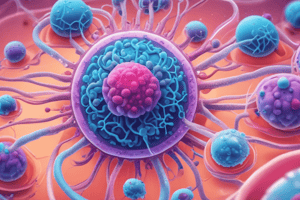Podcast
Questions and Answers
What are the four main groups into which Streptococcus bacteria are often clustered?
What are the four main groups into which Streptococcus bacteria are often clustered?
- Anaerobic streptococci (correct)
- Other streptococci (correct)
- Oral streptococci (correct)
- Pyogenic streptococci (correct)
What was the family of the genus Streptococcus in the first edition of Bergey's manual?
What was the family of the genus Streptococcus in the first edition of Bergey's manual?
Streptococcaceae
Which two new genera were created from species previously in the genus Streptococcus?
Which two new genera were created from species previously in the genus Streptococcus?
Enterococcus and Lactococcus
What is the domain and phylum of the genus Streptococcus?
What is the domain and phylum of the genus Streptococcus?
List three types of hemolytic patterns.
List three types of hemolytic patterns.
Match the following groups of streptococci with their characteristics:
Match the following groups of streptococci with their characteristics:
Who developed the serologic classification scheme for streptococci?
Who developed the serologic classification scheme for streptococci?
All streptococci have Lancefield antigens.
All streptococci have Lancefield antigens.
What caused the outbreak associated with Streptococcus suis in pigs in China in 2005?
What caused the outbreak associated with Streptococcus suis in pigs in China in 2005?
What are the general characteristics of Streptococcus members?
What are the general characteristics of Streptococcus members?
What is the G+C content range of streptococci genomes?
What is the G+C content range of streptococci genomes?
Flashcards are hidden until you start studying
Study Notes
Taxonomy
- Genus Streptococcus is large and complex, categorized into four main groups.
- Pyogenic streptococci: Includes S. pyogenes (causes strep throat) and S. agalactiae.
- Oral streptococci: Notably includes S. mutans (associated with dental caries) and S. pneumoniae.
- Anaerobic streptococci: Includes S. morbillorum.
- Other streptococci: Includes S. bovis.
Taxonomy History
- First included in Bergey's manual under family Streptococcaceae, which had ten genera.
- Major revisions since 1980 led to the creation of Enterococcus and Lactococcus from species within Streptococcus.
Taxonomy Present
- Domain: Bacteria
- Phylum: Firmicutes
- Class: Bacilli
- Order: Lactobacillales
- Family: Streptococcaceae, now with three genera: Streptococcus, Lactococcus, Lactovum.
Groups
- Sixteen S rRNA gene sequence analyses reveal seven multispecies phylogenetic units within Streptococcus sensu stricto.
- Includes multiple groups: Pyogenic, S. bovis, S. anginosus, S. mitis, S. mutans, S. salivarius, and an unaffiliated group (S. suis).
- Last four phylogenetic clusters are categorized as Viridans group streptococci.
Viridans Group Streptococci
- Comprises a heterogeneous group that can act as commensal flora or pathogens in humans.
- Inclusive of four phylogenetic clusters: Mitis, Mutans, Salivarius, and Anginosus.
Classification Schemes
- Classification of Streptococcus spp. utilizes three schemes:
- Hemolytic pattern on sheep RBC
- Serologic properties
- Biochemical properties (fermentation/enzymes)
Hemolytic Pattern
- Three main types of hemolysis:
- Beta-hemolysis: Complete lysis of RBC, clear zone.
- Alpha-hemolysis: Partial lysis, greenish color.
- Gamma-hemolysis: No lysis, no color change (non-hemolytic).
- S. pyogenes and S. agalactiae are β -hemolytic; most human pathogens are α-hemolytic.
Serologic Properties
- Developed by Rebecca Lancefield in the 1930s, based on group-specific antigenic composition (Lancefield antigens).
- Classifies mainly β -hemolytic streptococci into groups A-T.
- Group A includes S. pyogenes, B includes S. agalactiae, C includes S. equi, and D includes S. bovis.
- S. pneumoniae and viridans streptococci are termed non-groupable.
Outbreak Associated with Streptococcus suis in Pigs (2005)
- S. suis infection results from contact with or consuming infected pigs.
- Outbreak linked to a single strain, confirmed through ribotyping.
General Properties
- Gram-positive cocci or ovoid (0.5-2 μm), appear singly, in pairs, and chains.
- Non-motile, non-sporeforming, some encapsulated.
- Fastidious nutrition needs enriched media, facultative anaerobes, homofermentative (producing lactic acid from glucose fermentation).
- Catalase-negative and oxidase-negative, distinguishing them from Neisseria species.
- Susceptible to vancomycin.
Genomes of Streptococci
- Genome sizes range from 1800-2500 kb; S. pyogenes is 1.9 Mb, S. pneumoniae is 2 Mb.
- G+C content ranges from 34-46%, indicating low to medium G+C content.
Studying That Suits You
Use AI to generate personalized quizzes and flashcards to suit your learning preferences.




